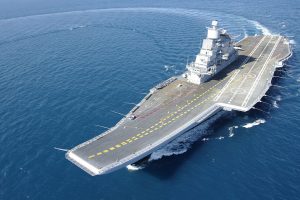COVID-19 has slowed, but not frozen, the progress of India’s aircraft carrier aspirations. INS Vikrant, India’s first indigenously built carrier, will soon enter sea trials. Basin trials, which test certain systems (including propulsion and electrical) that require contact with water, began this month. Assuming all goes well, the carrier will enter sea trials in December. Still, serious questions remain about India’s carrier program, questions that the pandemic has complicated.
Laid down in 2013, Vikrant will displace some 45,000 tons and is expected to carry 26 MiG-29K fighters along with 10 helicopters. She will be comparable in size and capability to INS Vikramaditya, acquired from Russia in 2014 after a long, difficult process of refurbishment and modernization. Once Vikrant enters service the Indian Navy will, for the first time in its long history, be able to operate two modern aircraft carriers at the same time, and likely be able to keep at least one in service at all times. Expectations for Vikrant’s entry into full service remain unclear, but current reports suggest early 2023. This represents a significant delay from the navy’s original plans, which had hoped to see the ship in service by 2021. The COVID-19 pandemic has reportedly had a negative impact on the construction and testing process, implying that further delays are possible based on the course of the pandemic.
It is tempting but dangerous to compare India’s carrier progress with that of China, given that the two programs started at different points and have different strategic rationales. Nevertheless, some comparison between the Indian and Chinese naval aviation programs is warranted. As of 2010, neither country had ever built a warship of larger than 40,000 tons, or an aircraft carrier of any size. However, India had maintained a carrier aviation arm since the acquisition of the first INS Vikrant from the United Kingdom in 1961. India complemented Vikrant with Viraat (the ex-HMS Hermes) in 1986, maintaining both carriers until 1997. Viraat remained in service, thus providing for the maintenance of a nucleus of a group of pilots and aircrew, until 2015, after the acquisition of Vikramaditya.
China started well behind India, having no notable naval aviation tradition to draw upon before the commissioning of the former Ukrainian carrier Liaoning in 2012. It took four years for Liaoning to reportedly reach combat capability; during that time, China laid down a second carrier (Shandong, commissioned in 2019) and a third ship of considerably larger dimensions than the previous two. China’s carriers operate J-15 fighters, a carrier-borne Flanker variant, and China is clearly exploring the development of carrier-borne stealth fighters and early-warning aircraft.
Carrier aviation is an extremely difficult discipline to build from scratch, and as such the Indian Navy’s experience and its connections with both the Royal Navy and the United States Navy gave it an enormous head start. It is evident at this point, however, that India has not been able to take advantage of that head start, and has fallen behind the PLAN in terms of carrier capabilities for the first time since 1961. It surely bears mentioning that Shandong entered sea trials only three years after being laid down, a milestone that the builders of Vikrant have not achieved after more than seven years. Moreover, Liaoning and Shandong are some 50 percent larger than their Indian counterparts.
Expectations for further construction remain uncertain. INS Vishal, a proposed 65,000 follow-on to Vikrant, has not yet been laid down, and elements of the Indian defense establishment have expressed skepticism as to the value of the project. Skirmishes along India’s mountainous border with China have raised difficult questions regarding the utility of building expensive aircraft carriers to manage the Chinese threat. To be sure, Vikrant and Vikramaditya can pose a major threat to China’s lines of maritime communication even if Vishal is never laid down, and even if China’s lead in the carrier race continues to grow; such is the value of having friends like Japan and the United States. Nevertheless, hard questions about Indian naval procurement and grand strategy remain to be answered.

































